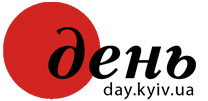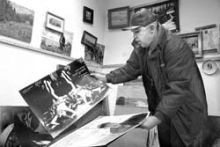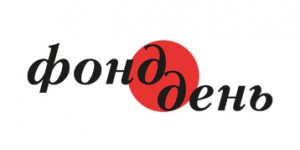Ukrainian antiques are becoming more and more popular. How else can one explain the increasingly frequent attempts to smuggle them out of Ukraine? For example, still fresh are memories of a Ukrainian-American who tried to smuggle 376 icons to the US. Recently, officers of the Central Department for Combating Organized Crime jointly with their Hungarian colleagues exposed an organized crime ring that smuggled antiques across Ukraine’s border to be further sold in Western Europe. The customs officers on the Austro-Hungarian border detained the leader of the ring of smugglers, who attempted to smuggle fifty antiques such as oil lamps and buckles of the Gothic period. They discovered over 1,000 artworks in his Budapest apartment.
FOLLOWING MARGARET THATCHER’S ADVICE INSTEAD OF INSTRUCTIONS
As The Day learned from Vitaly Mayorov, chief of the Boryspil Customs Information Analysis Department, in 2003 the State Customs Service foiled 350 attempts to smuggle antiques out of the country. Meanwhile, in the two first months of 2004 of the 120 reported customs violations, seven cases involved attempts to smuggle cultural artifacts. Customs officers recall how on January 28 they detained a painting by post-futuristic avant-garde painter Solomon Nikritin, A Trip Around the World, appraised at UAH 272,508. The painting was on its way to Greece, sent by a state-run company. And although it had a permit to leave the country, it had been issued without any prior expert appraisal.
Among the things most often seized by customs officials are paintings, coins, snuff boxes, silverware, medals and decorations, old gold watches, icons, engravings, books, and letters. According to State Monitoring Service commissioner Yevhen Halushkevych, for an artwork to leave Ukraine it must pass several stages, the first being expert appraisal. Second, the person must prove that he is the legitimate owner of the artifact in question. Whenever doubt arises, a chemical examination is performed. Then the artifact is checked with the State Register of the Nation’s Cultural Heritage. If it belongs there, the artifact cannot leave the country. If the artifact in question is of no value to the state, the customs service issues a numbered permit.
According to a customs officer, the register mentioned lists only artifacts stolen from museums or private collections that are of cultural or historical value to Ukraine. There are plans to update this list, but as yet nobody is in any hurry to do so. Experts claim that it is so imperfect that with a little more effort one could leave the country with the Golden Pectoral or Oranta from the St. Sophia Cathedral. Thus, as customs arts experts put it, we follow more Margaret Thatcher’s advice to listen to our common sense than the recommended instructions.
As a rule, everything that is seized by court order passes to more reliable owners. Icons, for example, are passed to churches or other religious establishments. In general, further destiny of seized artifacts is decided by the Interdisciplinary Council for Import and Export of Cultural Artifacts. Vira Vynohradova, director of the Khanenkos Museum of West European Art, says that her museum receives presents from the customs service almost every year. Recently, her exposition added a set of Buddhist icons.
A MONA LISA FOR BIRTHDAY
As for the domestic antiquities market, today experts speak of a real boom. According to Fedir Zernetsky, director of a Ukrainian antique shop, the recent fad has been to give antiques for someone’s birthday. In this way many prominent and otherwise Ukrainians suddenly become passionate collectors. Olena Hladkaya explains this phenomenon by the desire to buy old things. The person thus wants to return to the past and relive the days when he or she felt happy. For this reason, people begin collecting antiques after they are forty, during the so-called middle age crisis, when they begin to reexamine their lives.
Moreover, buying antiques is a wise investment, since artworks become more and more expensive with each passing year.
Today Russian antiques top the popularity list followed by Ukrainian artists of the twentieth century such as Hlushchenko, Shyshko, Shovkunenko, and Trofymenko. Western artworks are in demand more as elements of interior design than collectibles. Western silverware items such as big vases, cups, tableware, and writing utensils are very popular. Western genre paintings are also in demand.
“In principle, first-class artists are sparsely represented on Ukraine’s antiquities market,” says Olena Zhyvkova, head of the West European Art Department in the Khanenkos Arts Museum. “This is due to Ukraine’s history replete with wars and armed conflicts, during which a stunning number of rarities were stolen, smuggled out of the country, or destroyed. Since more of the Western antiques have lasted to this day, they are sometimes even cheaper than Ukrainian antiques.”
INDEPENDENT DEPENDENCE
Today the employees of state-run museums closely cooperate with private antique dealers. This is due to a number of objective reasons. Like many other countries Ukraine has few independent experts who would satisfy the demand of the antiquities market. Under such circumstances, this as yet unoccupied niche has been filled by museum employees. There is nothing wrong with a museum employee advising the future owner of an artwork on its real value. Rather, this cooperation is mutually beneficial, as the art expert can thus enhance his skills and the collector obtain more or less accurate information. The line of legitimacy of such cooperation is particularly thin when art experts issue certificates written on museum letterheads confirming the value, artistic and otherwise, of the artwork in question.
“Respectable antique dealers provide their artworks with expert certificates issued by independent museum specialists. But whether there are museum employees independent of the museums they work for is a different question,” says Olena Zhyvkova.
Hence another problem of a strictly museum nature. Sometimes big antique dealers offer high quality artworks, which could be put on display in museums. There are two main criterions, namely high artistic value and good condition of the artwork. “Kyiv’s antiquities market has many decent artworks, but who would buy them for our museums? For example, in the West owners of expensive collections display their treasures in museum expositions, the New York Metropolitan Museum being the best example of such cooperation. Each label bears the inscription ‘Property of such and such bank.’ People come to see these artworks, and this is also a way for the company that owns them to advertise itself,” says Ms. Zhyvkova.
“LOOKING FOR EXPENSIVE FAKES”
Ukraine’s antiquities market is overflowing with fakes. Olena Zhyvkova says that even rich private collections have many cheap works. Experts claim that at flea markets one can buy a high- priced fake or a genuine artwork on the cheap. The same rarities that once belonged to the old intelligentsia have been put up on sale by antique dealers or are being sold by that same elite of the past at flea markets. Although mostly banal things such as cameras, radios, painted and molded attributes of the former USSR catch the eye there, art experts say that a successful acquisition depends on the collector’s purposefulness and general level of education.
How these things get here is no secret. “In the 1970s I was a track and field athlete,” says Valery, a flea market salesman. “I traveled everywhere, bought and collected things. Now my daughter is a university student. I have to pay tuition, while the flea market is my only source of income.”







